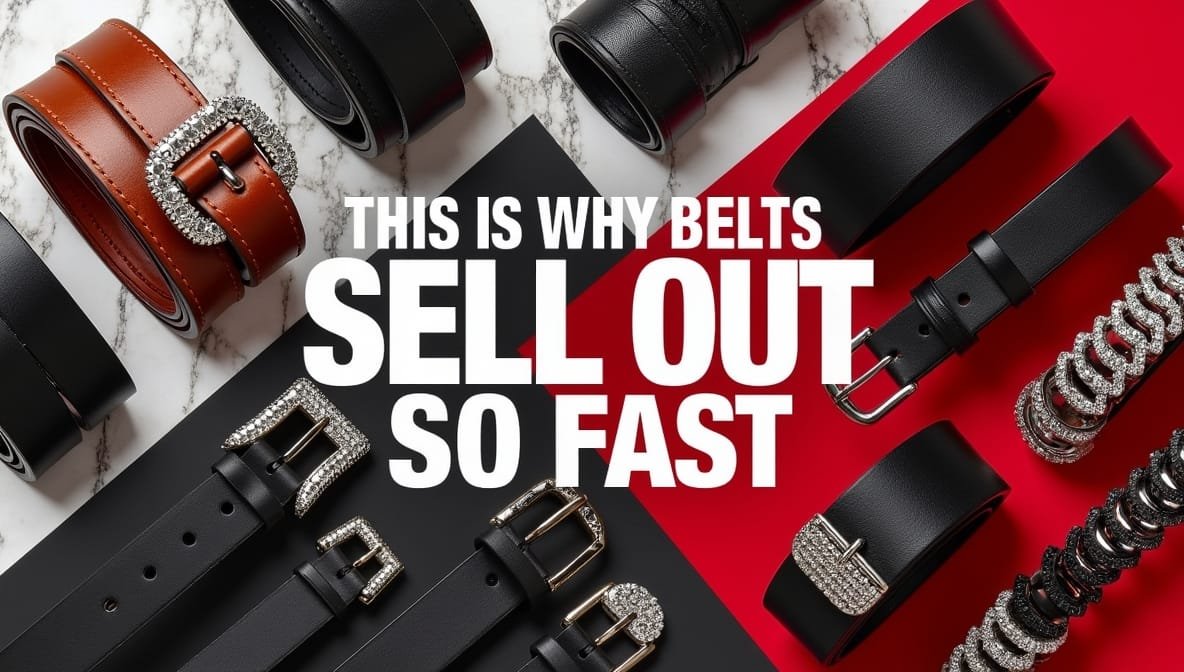This Is Why Belts Sell Out So Fast

In the whirlwind tapestry of couture, where trends flicker like fireflies, a rare breed of accessory breaches mere function—ascending into the echelons of iconography. The belt, shimmering with decadent opulence, doesn’t just decorate a waistline—it coronates it. But what ignites this insatiable hunger for buckled brilliance? Let us unravel the mystique that renders these belts phantom apparitions on store shelves, perpetually sold out.
The Origins of Belts Sell
Forged in the mind of Simon Tavassoli in 1987, belts were birthed not to blend but to blaze. Tavassoli sculpted these pieces from a dream laced with luxe and cultural cross-pollination. Each belt became a canvas—swirling with ancestral motifs, Gothic glam, and baroque excess. Time hasn’t tamed them; they’ve metamorphosed with the shifting couture currents but preserved their marrow-deep identity—daring, defiant, distinguished.
Craftsmanship and Materials of Belts Sell
At their core, belts are sacred relics of artisan excellence. Not spit from conveyor belts but whispered into existence by human hands within U.S. soil. Italian calfskin—soft as whispered sin—lays the groundwork, then is drenched in legitimate Swarovski encrustations. These are not accessories; they are wearable shrines. Traditional crafting rites intermingle with modern flamboyance, yielding belts that are both vintage-tinged and forward-striding.
Cultural Impact and Celebrity Endorsements
Their explosion in pop-cultural consciousness? Not an accident—an eruption. Early aughts hip-hop icons anointed these belts: Lil Wayne, Kanye West, and Rihanna—each turning a glimmering strap into a status totem. With them, belts became more than adornments—they became proclamations of ascent. Symbols of rebellion wrapped in rhinestones. They strode stages, strutted carpets, and stamped themselves into the lexicon of bling.
Limited Editions and Exclusivity of Belts Sell
does not mass-produce. They curate. They ration art. Their limited editions are invitations to an elite sanctum. Only a handful of wrists will buckle each design, intensifying lust and magnifying scarcity. That ephemeral quality—blink and it’s gone—transmutes every release into a collector’s pursuit. These aren’t belts; they’re obsessions in leather and light.
Marketing Strategies and Brand Positioning
Unlike brash billboard brands, whispers tales—echoes of legacy, opulence, and rebellion. They don’t hawk belts—they enchant patrons. Their campaigns are drenched in mystique, with artist pairings and enigmatic drops feeding a cultish following. Each product isn’t a purchase—it’s a pledge to individuality, to decadence, to the strange and spectacular.
Consumer Psychology and Perceived Value
Owning a isn’t acquisition—it’s initiation. It affirms alignment with an echelon where expression overrules conformity. The belt’s radiance and meticulous artistry serve as talismans of taste and triumph. Buyers aren’t shopping; they’re consecrating their style ethos. Price becomes secondary, shadowed by the emotional prestige each belt bestows.
Challenges in Meeting Demand
Because every piece is hand-conjured, time becomes the bottleneck. Precision can’t be rushed. refuses to dilute its quality for quantity’s sake. As demand swells globally, production limps respectfully behind, clutching its artisanal standards. This constraint—both bane and blessing—means scarcity persists. And in scarcity, desire ferments.
Counterfeit Market and Its Implications
Fame draws phantoms. The counterfeiting hydra rears its head—spewing imitation belts with rhinestones duller than broken dreams. These forgeries sully the brand’s sanctity and mislead the unsuspecting. But is vigilant—deploying embedded codes, hidden emblems, and branding sigils to guard authenticity like a cryptic talisman.
Future Prospects and Innovations
The brand tiptoes the tightrope between heritage and reinvention. They toy with novel textiles, bizarre silhouettes, and avant-garde collaborations. Evolution courses through their veins—unafraid, unbound. Yet, they anchor every forward step in the same ethos: fierce identity, baroque soul, unrepentant brilliance.
FAQs
Q1: What materials are used in belts?
A1: Only the crème de la crème—Italian leather kissed by skilled hands and dusted with authentic Swarovski crystals. It’s durability dressed in decadence.
Q2: How can I verify the authenticity of a belt?
A2: Seek the cryptic cues—engraved emblems, serial insignias, and QR codex. Only buy from the high altar: the official site or its sanctified sellers.
Q3: Why are belts often out of stock?
A3: They’re born slowly, with reverence, not rushed like disposable trends. Demand outpaces birthrate. Art takes time.
Q4: Are there counterfeit belts in the market?
A4: Like shadows to fire, fakes follow fame. But it defends its light with codes, marks, and unmistakable opulence.
Q5: Does it plan to expand its product range?
A5: While belts remain their signature hymn, murmurs of expansion swirl—new forms, new tales, but always the same uncompromised soul.
Conclusion
The belt is not just fast fashion—it’s a fever. A talisman. A spectacle of flair fused with folklore. Their vanishing-from-shelves speed is no mystery—it’s the result of a symphony of exclusivity, allure, legacy, and craftsmanship that no machine could mimic. Each piece is a manifesto, not merchandise.
